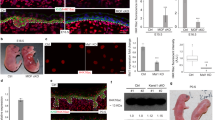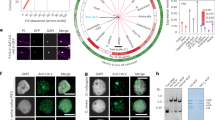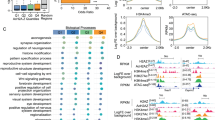Abstract
A wide variety of nuclear regulators and enzymes are subjected to acetylation of the lysine residue, which regulates different aspects of protein functions. The MYST family histone acetyltransferase, human ortholog of MOF (hMOF), plays critical roles in transcription activation by acetylating nucleosomal H4K16. In this study, we found that hMOF acetylates itself in vitro and in vivo, and the acetylation is restricted to the conserved MYST domain (C2HC zinc finger and HAT), of which the K274 residue is the major autoacetylation site. Furthermore, the class III histone deacetylase SIRT1 was found to interact with the MYST domain of hMOF through the deacetylase catalytic region and deacetylate autoacetylated hMOF. In vitro binding assays showed that non-acetylated hMOF robustly binds to nucleosomes while acetylation decreases the binding ability. In HeLa cells, the recruitment of hMOF to the chromatin increases in response to SIRT1 overexpression and decreases after knockdown of SIRT1. The acetylation mimic mutation K274Q apparently decreases the chromatin recruitment of hMOF as well as the global H4K16Ac level in HeLa cells. Finally, upon SIRT1 knockdown, hMOF recruitment to the gene body region of its target gene HoxA9 decreases, accompanied with decrease of H4K16Ac at the same region and repression of HoxA9 transcription. These results suggest a dynamic interplay between SIRT1 and hMOF in regulating H4K16 acetylation.
Similar content being viewed by others
Log in or create a free account to read this content
Gain free access to this article, as well as selected content from this journal and more on nature.com
or
References
Yang XJ . Lysine acetylation and the bromodomain: a new partnership for signaling. Bioessays 2004; 26:1076–1087.
Kouzarides T . Acetylation: a regulatory modification to rival phosphorylation? EMBO J 2000; 19:1176–1179.
Yang XJ, Seto E . Lysine acetylation: codified crosstalk with other posttranslational modifications. Mol Cell 2008; 31:449–461.
Zhao S, Xu W, Jiang W, et al. Regulation of cellular metabolism by protein lysine acetylation. Science 2010; 327:1000–1004.
Santos-Rosa H, Valls E, Kouzarides T, Martinez-Balbas M . Mechanisms of P/CAF auto-acetylation. Nucleic Acids Res 2003; 31:4285–4292.
Black JC, Choi JE, Lombardo SR, Carey M . A mechanism for coordinating chromatin modification and preinitiation complex assembly. Mol Cell 2006; 23:809–818.
Thomas T, Voss AK . The diverse biological roles of MYST histone acetyltransferase family proteins. Cell Cycle 2007; 6:696–704.
Voss AK, Thomas T . MYST family histone acetyltransferases take center stage in stem cells and development. Bioessays 2009; 31:1050–1061.
Lemercier C, Legube G, Caron C, et al. Tip60 acetyltransferase activity is controlled by phosphorylation. J Biol Chem 2003; 278:4713–4718.
Wang J, Chen J . SIRT1 regulates autoacetylation and histone acetyltransferase activity of TIP60. J Biol Chem 2010; 285:11458–11464.
Gu W, Szauter P, Lucchesi JC . Targeting of MOF, a putative histone acetyl transferase, to the X chromosome of Drosophila melanogaster. Dev Genet 1998; 22:56–64.
Akhtar A, Becker PB . Activation of transcription through histone H4 acetylation by MOF, an acetyltransferase essential for dosage compensation in Drosophila. Mol Cell 2000; 5:367–375.
Morales V, Straub T, Neumann MF, Mengus G, Akhtar A, Becker PB . Functional integration of the histone acetyltransferase MOF into the dosage compensation complex. EMBO J 2004; 23:2258–2268.
Smith ER, Cayrou C, Huang R, Lane WS, Cote J, Lucchesi JC . A human protein complex homologous to the Drosophila MSL complex is responsible for the majority of histone H4 acetylation at lysine 16. Mol Cell Biol 2005; 25:9175–9188.
Dou Y, Milne TA, Tackett AJ, et al. Physical association and coordinate function of the H3 K4 methyltransferase MLL1 and the H4 K16 acetyltransferase MOF. Cell 2005; 121:873–885.
Taipale M, Rea S, Richter K, et al. hMOF histone acetyltransferase is required for histone H4 lysine 16 acetylation in mammalian cells. Mol Cell Biol 2005; 25:6798–6810.
Choudhary C, Kumar C, Gnad F, et al. Lysine acetylation targets protein complexes and co-regulates major cellular functions. Science 2009; 325:834–840.
Vaziri H, Dessain SK, Ng Eaton E, et al. hSIR2(SIRT1) functions as an NAD-dependent p53 deacetylase. Cell 2001; 107:149–159.
Sykes SM, Mellert HS, Holbert MA, et al. Acetylation of the p53 DNA-binding domain regulates apoptosis induction. Mol Cell 2006; 24:841–851.
Vaquero A, Scher MB, Lee DH, et al. SirT2 is a histone deacetylase with preference for histone H4 Lys 16 during mitosis. Genes Dev 2006; 20:1256–1261.
Miller KM, Tjeertes JV, Coates J, et al. Human HDAC1 and HDAC2 function in the DNA-damage response to promote DNA nonhomologous end-joining. Nat Struct Mol Biol 2010; 17:1144–1151.
Larschan E, Alekseyenko AA, Gortchakov AA, et al. MSL complex is attracted to genes marked by H3K36 trimethylation using a sequence-independent mechanism. Mol Cell 2007; 28:121–133.
Wang Z, Zang C, Cui K, et al. Genome-wide mapping of HATs and HDACs reveals distinct functions in active and inactive genes. Cell 2009; 138:1019–1031.
Shogren-Knaak M, Ishii H, Sun JM, Pazin MJ, Davie JR, Peterson CL . Histone H4-K16 acetylation controls chromatin structure and protein interactions. Science 2006; 311:844–847.
Gupta A, Sharma GG, Young CS, et al. Involvement of human MOF in ATM function. Mol Cell Biol 2005; 25:5292–5305.
Sharma GG, So S, Gupta A, et al. MOF and histone H4 acetylation at lysine 16 are critical for DNA damage response and DSB repair. Mol Cell Biol 2010; 30:3582–95.
Chin HG, Esteve PO, Pradhan M, et al. Automethylation of G9a and its implication in wider substrate specificity and HP1 binding. Nucleic Acids Res 2007; 35:7313–7323.
Kim MY, Mauro S, Gevry N, Lis JT, Kraus WL . NAD+-dependent modulation of chromatin structure and transcription by nucleosome binding properties of PARP-1. Cell 2004; 119:803–814.
Vaquero A, Scher M, Lee D, Erdjument-Bromage H, Tempst P, Reinberg D . Human SirT1 interacts with histone H1 and promotes formation of facultative heterochromatin. Mol Cell 2004; 16:93–105.
Bouras T, Fu M, Sauve AA, et al. SIRT1 deacetylation and repression of p300 involves lysine residues 1020/1024 within the cell cycle regulatory domain 1. J Biol Chem 2005; 280:10264–10276.
Fulco M, Schiltz RL, Iezzi S, et al. Sir2 regulates skeletal muscle differentiation as a potential sensor of the redox state. Mol Cell 2003; 12:51–62.
Vaquero A, Scher M, Erdjument-Bromage H, Tempst P, Serrano L, Reinberg D . SIRT1 regulates the histone methyl-transferase SUV39H1 during heterochromatin formation. Nature 2007; 450:440–444.
Pruitt K, Zinn RL, Ohm JE, et al. Inhibition of SIRT1 reactivates silenced cancer genes without loss of promoter DNA hypermethylation. PLoS Genet 2006; 2:e40.
Mendjan S, Taipale M, Kind J, et al. Nuclear pore components are involved in the transcriptional regulation of dosage compensation in Drosophila. Mol Cell 2006; 21:811–823.
Cai Y, Jin J, Swanson SK, et al. Subunit composition and substrate specificity of a MOF-containing histone acetyltransferase distinct from the male-specific lethal (MSL) complex. J Biol Chem 2010; 285:4268–4272.
Li X, Wu L, Corsa CA, Kunkel S, Dou Y . Two mammalian MOF complexes regulate transcription activation by distinct mechanisms. Mol Cell 2009; 36:290–301.
Akhtar A, Becker PB . The histone H4 acetyltransferase MOF uses a C2HC zinc finger for substrate recognition. EMBO Rep 2001; 2:113–118.
Raja SJ, Charapitsa I, Conrad T, et al. The nonspecific lethal complex is a transcriptional regulator in Drosophila. Mol Cell 2010; 38:827–841.
Kadlec J, Hallacli E, Lipp M, et al. Structural basis for MOF and MSL3 recruitment into the dosage compensation complex by MSL1. Nat Struct Mol Biol 2011; 18:142–149.
Takata T, Ishikawa F . Human Sir2-related protein SIRT1 associates with the bHLH repressors HES1 and HEY2 and is involved in HES1- and HEY2-mediated transcriptional repression. Biochem Biophys Res Commun 2003; 301:250–257.
Dai JM, Wang ZY, Sun DC, Lin RX, Wang SQ . SIRT1 interacts with p73 and suppresses p73-dependent transcriptional activity. J Cell Physiol 2007; 210:161–166.
Zhang R, Chen HZ, Liu JJ, et al. SIRT1 suppresses activator protein-1 transcriptional activity and cyclooxygenase-2 expression in macrophages. J Biol Chem 2010; 285:7097–7110.
Brunet A, Sweeney LB, Sturgill JF, et al. Stress-dependent regulation of FOXO transcription factors by the SIRT1 deacetylase. Science 2004; 303:2011–2015.
Xu M, Long C, Chen X, Huang C, Chen S, Zhu B . Partitioning of histone H3-H4 tetramers during DNA replication-dependent chromatin assembly. Science 2010; 328:94–98.
Godde JS, Nakatani Y, Wolffe AP . The amino-terminal tails of the core histones and the translational position of the TATA box determine TBP/TFIIA association with nucleosomal DNA. Nucleic Acids Res 1995; 23:4557–4564.
Acknowledgements
This work was supported by the National Basic Research Program Grants 2011CB965203, 2011CB964803 and 2011CB503902, Hi-Tech Research and Development Program of China Grant 2007AA021206 and the National Natural Science Foundation of China Grants 31030026 and 31021091.
Author information
Authors and Affiliations
Corresponding author
Additional information
( Supplementary information is linked to the online version of the paper on the Cell Research website.)
Supplementary information
Supplementary information, Figure S1
In vitro autoacetylation of hMOF. (PDF 987 kb)
Supplementary information, Figure S2
In vitro autoacetylation of GST-hMOF constructs. (PDF 920 kb)
Supplementary information, Figure S3
In vitro HAT assay was carried out using FLAG-IP purified mammalian hMOF-K274R complex. (PDF 1163 kb)
Supplementary information, Figure S4
Measurement of H4K16Ac levels from blank HeLa cells and HeLa cells with ectopic hMOF expression. (PDF 988 kb)
Supplementary information, Table S1
Primers used in this study. (PDF 24 kb)
Rights and permissions
About this article
Cite this article
Lu, L., Li, L., Lv, X. et al. Modulations of hMOF autoacetylation by SIRT1 regulate hMOF recruitment and activities on the chromatin. Cell Res 21, 1182–1195 (2011). https://doi.org/10.1038/cr.2011.71
Received:
Revised:
Accepted:
Published:
Issue date:
DOI: https://doi.org/10.1038/cr.2011.71
Keywords
This article is cited by
-
KAT8 acetylation-controlled lipolysis affects the invasive and migratory potential of colorectal cancer cells
Cell Death & Disease (2023)
-
Acetylation of PAX7 controls muscle stem cell self-renewal and differentiation potential in mice
Nature Communications (2021)
-
Chidamide epigenetically represses autophagy and exerts cooperative antimyeloma activity with bortezomib
Cell Death & Disease (2020)
-
SIRT1 deacetylates the cardiac transcription factor Nkx2.5 and inhibits its transcriptional activity
Scientific Reports (2016)
-
Functional interplay between MSL1 and CDK7 controls RNA polymerase II Ser5 phosphorylation
Nature Structural & Molecular Biology (2016)



